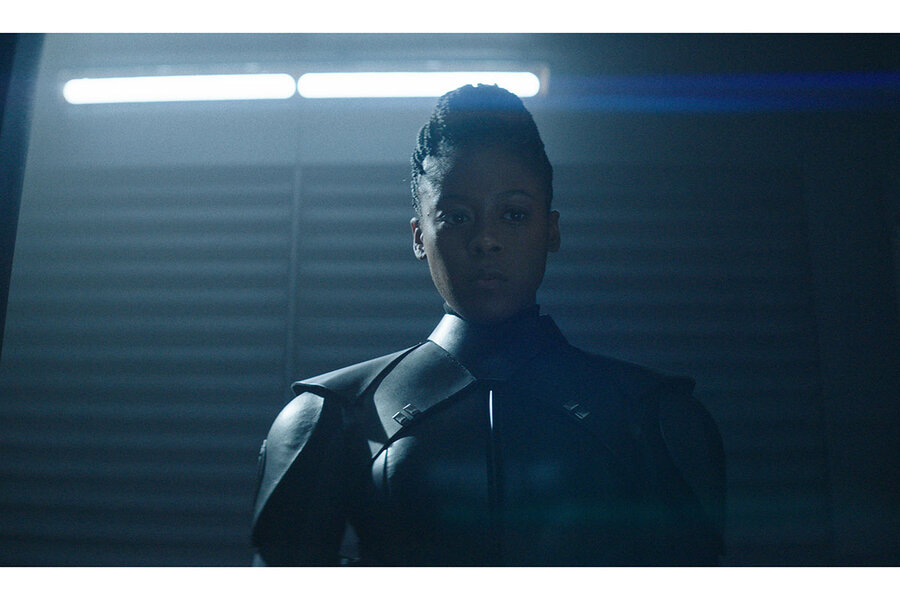‘Star Wars’ and race: It’s complicated, but improving
The “Star Wars” franchise’s sometimes problematic history with race has always been unfortunate and ironic.
The most recognizable voice from the stories is that of a Black man, a legacy that proudly continues. And yet, when the face of that villain was revealed decades ago, we saw the face of a white man. Looking back on it today, James Earl Jones’ voice matched with Sebastian Shaw’s face felt like a twisted prequel of “Get Out,” the satirical horror film where Black people’s minds and bodies are suppressed and subverted by white people.
Walt Disney Studios had a chance to rectify this sordid space history in 2015 with “Star Wars: Episode VII – The Force Awakens.” John Boyega, an up-and-coming actor, starred as Finn and wowed casual fans with his fresh face and wit. We saw a glimpse of his potential and his joy as he viewed himself in the trailer for “The Force Awakens.” We saw the look in his eye as the preview progressed, and then he saw himself with a lightsaber. His reaction was palpable, the type of reaction a child might have when he sees the flash from a toy sword for the first time. It was a sign that things might change in the “Star Wars” universe.
Why We Wrote This
Casting “Star Wars” stories for the screen can be fraught. Actors of color, in particular, often face scrutiny and backlash. But a speedy official response recently suggests an effort to help society move toward more tolerance.
And then, just as quickly, the “dark side” appeared – specifically, the ugliness of fan backlash. Some were angry with the Jedi-to-be’s chemistry with Rey, played by Daisy Ridley, who is white; some were angry with his presence overall.
That was seven years ago, and as the new “Star Wars” series, “Obi-Wan Kenobi,” premiered on Disney+ at the end of May, it looked like some things might never change when a racist faction of fans attacked Moses Ingram and her role as the villainous Reva.
This time, the universe spoke, via the official Instagram and Twitter accounts for “Star Wars”: “We are proud to welcome Moses Ingram to the Star Wars family and excited for Reva’s story to unfold. If anyone intends to make her feel in any way unwelcome, we have only one thing to say: we resist.”
Adding in a subsequent tweet, “There are more than 20 million sentient species in the Star Wars galaxy, don’t choose to be a racist.”
It was a deliberate and different commentary, even in an age where protest is perpetual. It goes without saying that Mr. Boyega’s circumstances, which he outlined in Britain’s incarnation of GQ, likely factored into Disney’s rebuke of fan hatred. (The recent online bullying of Kelly Marie Tran, an Asian actor, may also have played a role.)
“I’m the only cast member who had their own unique experience of that franchise based on their race,” Mr. Boyega told the publication. “It makes you angry with a process like that. It makes you much more militant; it changes you. Because you realise, ‘I got given this opportunity but I’m in an industry that wasn’t even ready for me.’ Nobody else in the cast had people saying they were going to boycott the movie because [they were in it]. Nobody else had the uproar and death threats sent to their Instagram DMs and social media, saying, ‘Black this and black that and you shouldn’t be a Stormtrooper.’ Nobody else had that experience.”
Certainly, there have been Black characters in the “Star Wars” canon – Mace Windu and Lando Calrissian come to mind. The concern for Black fans of the series is the second-fiddle roles that those characters have played. Windu, who was played by Samuel L. Jackson, was poised to thwart the Dark Side in “Star Wars: Episode III – Revenge of the Sith” until Anakin Skywalker made his shocking heel turn. Calrissian, played by Billy Dee Williams in the earlier “Star Wars” films, and by Donald Glover in “Solo: A Star Wars Story,” had a reputation as a trickster, and even with his hero turn, still was a largely misinterpreted character.
The challenge for “Star Wars” moving forward is to continue in this path of character development and critical rebuke of racism. The conscientious words of key figures in the latest series are important. And yet, we understand that wide-scale change happens when corporations change. It is fitting that Ms. Ingram would speak about the racism she has endured with defiance, yet lament, “There’s nothing anybody can do about this. There’s nothing anybody can do to stop this hate. ... But I think the thing that bothers me is ... this feeling that I’ve had inside of myself – which no one has told me – but this feeling that I’ve just got to shut up and take it. That I’ve just got to grin and bear it. And I’m not built like that.”
It shouldn’t be her problem to bear at all, much less alone. It’s the universe’s problem. Silence is consent, and in the vacuum of space, that silence has been deafening. There is something we can do about this. The quick and supportive official response to the hate, and more importantly, Mr. Boyega’s commentary, are good starting points.
In the face of this all-too-familiar scourge of the galaxy, it’s time to build something different. Not just characters, but character.
Ken Makin is the host of the “Makin’ A Difference” podcast.






